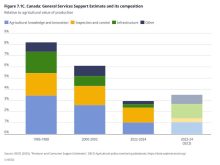The frequency of severe weather events is rising, but the federal government has yet to make it a priority, the federal environment commissioner has told Parliament in a special report.
Julie Gelfand’s office has audited federal programs between 2010 and 2015 and concluded that despite being the best positioned to lead with information and tools to mitigate the impact of floods, drought and other disasters, the federal government “has not put in place funding provisions to significantly improve the resilience of Canada’s infrastructure. Overall, we concluded that the federal government has not made it a priority to help decision makers mitigate the anticipated impacts of severe weather.”
Read Also

Canada’s agricultural innovation in crisis?
Experts argue that Canada’s ability to foster agricultural innovation and technology needs drastic improvement, and it needs to happen now
She noted scientists are predicting that extreme weather events, such as floods, droughts, and forest fires, will become more frequent and intense, putting aging and weakened infrastructure to an ever more difficult test.
“Studies show that dollars spent on mitigation efforts save money over time,” Gelfand said. “But to mitigate the effects of severe weather and ultimately save lives and money, decision makers need timely information and tools to inform their actions.”
It’s crucial to plan infrastructure for 2050 and beyond, she said.
“Canada must build resilient buildings, roads, bridges, water and sewage facilities, and transportation networks so that we can move around, work, keep the economy going, and live in vibrant and healthy communities,” Gelfand said.
“When resiliency is built into infrastructure, it is also built into communities, as they are then better equipped to recover more quickly when disasters strike.”
A number of federal departments could better contribute to preparedness, but Public Safety and Environment Canada haven’t provided provincial and municipal officials with the information and tools needed to address long-term severe weather effects. The National Research Council hasn’t incorporated climate change trends into National Building Code updates, which could impact buildings and structures for decades to come.
Flood plain maps and tools are required to measure the intensity, duration, and frequency of severe weather, she said.
“The federal government is uniquely positioned to support Canada-wide mitigation activities, helping avoid needless overlaps and gaps, and using government resources more efficiently,” Gelfand said.
The federal departments and agencies said in response to her criticisms they would step up their efforts to co-ordinate federal actions and programs with the needs of provinces and municipalities.
Gelfand said although the federal government has provided infrastructure funding for a decade, it has spent little on protecting them from severe weather events.
“We also found that the design of the mitigation programs did not encourage investments in infrastructure projects” to protect Canadians’ safety and security,” she said.
“The federal government’s contributions are too often piecemeal, too focused on the short term, and driven by what the government wants to put out instead of what end-users need.”
Governments across the country lack the information they need to guide the creation of resilient infrastructure for the future, Gelfand said.
“They need to know the current state of the infrastructure, which requires co-ordination among governments,” Gelfand said. “As things stand, the picture is incomplete.”
When environmental risks are not considered, projects may not be designed to minimize environmental effects or withstand the impacts of future weather events, she added. This means that municipalities could be left facing significant unexpected costs down the road.
The Building Canada Fund, the lead federal infrastructure program, has only five per cent of its approved projects that are related to disaster mitigation even though that is one of its priority areas.
“The fund is not designed to encourage provinces and territories to make disaster mitigation a priority,” Gelfand said.















